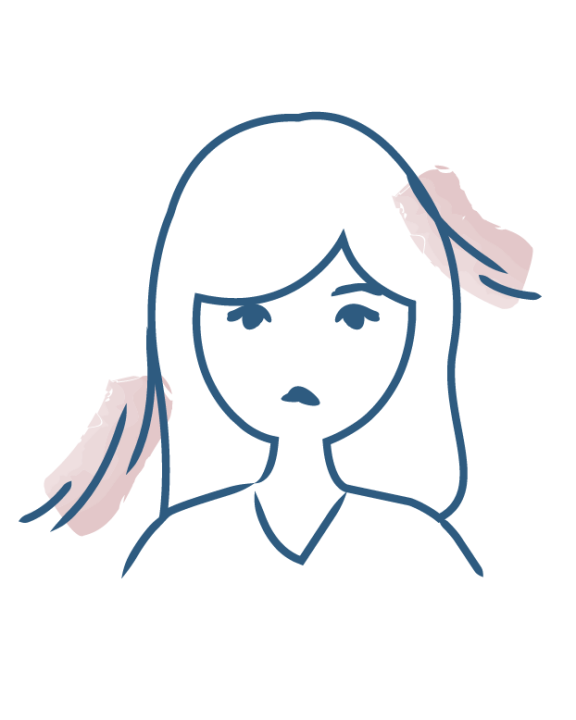What is hair loss?
Chronic loss of hair density
- The causes of hair loss
- Hair loss: the impact of iron, zinc, vitamin D, C and B12 deficiencies
- Drug-induced hair loss
- Hair loss and menopause
- Secondary syphilis and hair loss
- Hair loss and hormones
- What is traction alopecia?
- Hair loss and genetics
- Hair loss and fatigue
- Hair loss and the pill
- Hair loss due to stress: reactional hair loss
- Hair loss due to ringworm of the scalp
- Pregnancy and hair loss: everything you need to know
- Scarring alopecia
- Hair loss and Covid
- Spot baldness and hair loss

Chronic loss of hair density
Chronic telogen effluvium and androgenetic alopecia are two forms of chronic hair loss. Their origin is primarily hormonal but can, in some cases, be nutritional or metabolic.
Chronic telogen effluvium: information about the physiological mechanism at play
Unlike with reactional hair loss, which generally appears three to four months after a triggering factor, hair loss is considered chronic when it progresses over the course of at least six months. The scientific term for this condition is chronic telogen effluvium. Thyroid disorders, anorexia, iron deficiency (with or without anemia) as well as certain medicinal treatments (retinoids, anticoagulants, antihypertensive drugs, anticonvulsants, etc.) are among the causes. This type of hair loss leads to a shorter anagen phase, which in turn leads to shorter hair that goes through the hair cycle faster and falls out more often.
Hair loss in chronic telogen effluvium is less significant than in acute telogen effluvium (occasional hair loss). The latter generally manifests sporadically over the course of several years in middle-aged women who had thick, shiny hair originally. They complain of reduced length and volume.
Chronic androgenetic alopecia: the other form of chronic hair loss
What is androgenetic alopecia? Chronic hair loss is characterized by episodes of hair loss eventually leading to a miniaturization of the hair and a reduction in hair density. It affects mostly men at 70% to 80% versus 29% to 42% of women* over their lifetime, and is typically observed in men between the ages of 30 and 40. The mechanism by which male androgenetic alopecia manifests is hormonal and involves the androgen receptors found in the dermal papilla. Hair regrowth thus speeds up: it becomes depleted and gradually thinner until it eventually falls out permanently. To date, only two medicinal treatments are indicated to slow down this chronic hair loss: minoxidil and finasteride. The first is a topical treatment. The second is an oral treatment that can be prescribed to men only. Another, more expensive solution is available: hair implants.
* Source: (Blume-Peytavi et al., 2011; Norwood, 1975)
More information
- Discover Androgenetic alopecia in women and men
What is hair loss?
Androgenetic alopecia in women and men
- Discover Everything you need to know about seasonal hair loss
What is hair loss?
Everything you need to know about seasonal hair loss
- Discover Localized hair loss
What is hair loss?
Localized hair loss
- Discover The hair's life cycle
What is hair loss?
The hair's life cycle
- Discover Hair loss in men
What is hair loss?
Hair loss in men
- Discover Diffuse hair loss
What is hair loss?
Diffuse hair loss
- Discover Hair loss in women
What is hair loss?
Hair loss in women
Our care routines
Loss of hair density
- Discover MY OCCASIONAL HAIR DENSITY LOSS ROUTINE FOR MEN (LESS THAN 6 MONTHS)
MY OCCASIONAL HAIR DENSITY LOSS ROUTINE FOR MEN (LESS THAN 6 MONTHS)
Are you experiencing loss of hair density?
- Discover MY OCCASIONAL HAIR DENSITY LOSS ROUTINE FOR WOMEN (LESS THAN 6 MONTHS)
MY OCCASIONAL HAIR DENSITY LOSS ROUTINE FOR WOMEN (LESS THAN 6 MONTHS)
Are you losing your hair?
- Discover Anti-reactional loss of hair volume for post-pregnancy and breastfeeding women
Anti-reactional loss of hair volume for post-pregnancy and breastfeeding women
Like many young mothers, you are experiencing some discomfort following your pregnancy?
- Discover MY ROUTINE AGAINST CHRONIC HAIR DENSITY LOSS IN MEN (OVER 6 MONTHS)
MY ROUTINE AGAINST CHRONIC HAIR DENSITY LOSS IN MEN (OVER 6 MONTHS)
Are you losing your hair?
Dermatological expertise
To better understand your skin and hair, discover our exclusive content and innovative care products designed to improve your quality of life..


